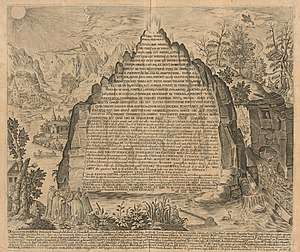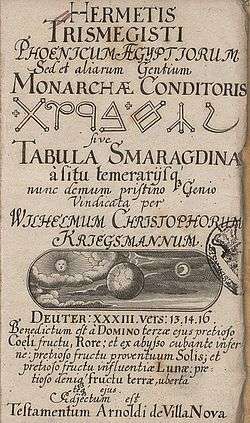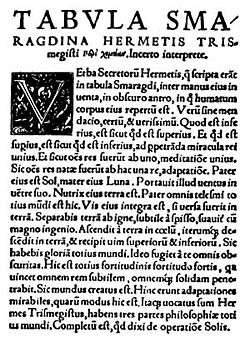Emerald Tablet
The Emerald Tablet, also known as the Smaragdine Tablet, or Tabula Smaragdina, is a compact and cryptic piece of the Hermetica reputed to contain the secret of the prima materia and its transmutation. It was highly regarded by European alchemists as the foundation of their art and its Hermetic tradition. The original source of the Emerald Tablet is unknown. Although Hermes Trismegistus is the author named in the text, its first known appearance is in a book written in Arabic between the sixth and eighth centuries. The text was first translated into Latin in the twelfth century. Numerous translations, interpretations and commentaries followed.

The layers of meaning in the Emerald Tablet have been associated with the creation of the philosopher's stone, as well as with other esoteric ideas.
Textual history
The text of the Smaragdine Tablet gives its author as Hermes Trismegistus ("Hermes the Thrice-Greatest"), a legendary Hellenistic[1] combination of the Greek god Hermes and the ancient Egyptian god Thoth.[2] Despite the claims of antiquity, it's believed to be an Arabic work written between the sixth and eighth centuries.[3] The oldest documentable source of the text is the "Kitab Balaniyus al-Hakim fi'l-`Ilal Kitāb sirr al-ḫalīqa" كتاب سر الخليقة و صنعة الطبيعة أو كتاب العلل للحكيم بلنياس (book of Balanius the wise on the Causes) written in Arabic between the sixth and eighth centuries. This volume is attributed to "Balinas" (or Pseudo-Apollonius of Tyana).[4] In his book, Balinas frames the Emerald Tablet as ancient Hermetic wisdom. He tells his readers that he discovered the text in a vault below a statue of Hermes in Tyana, and that, inside the vault, an old corpse on a golden throne held the emerald tablet.[5]
Following Balinas, an early version of the Emerald Tablet appeared in Kitab Sirr al-Asrar (Book of the Secret of Creation and the Art of Nature), a composite of earlier works, and in Kitab Ustuqus al-Uss al-Thani (Second Book of the Elements of Foundation) attributed to Jabir ibn Hayyan.[6] The Smaragdine Tablet was first translated into Latin in the twelfth century by Hugo of Santalla.[7] The text also appears in a thirteenth century edition of Secretum Secretorum.
The tablet text
Newton's translation

A translation by Isaac Newton is found among his alchemical papers that are currently housed in King's College Library, Cambridge University.[8]
Tis true without lying, certain and most true.
That which is below is like that which is above
and that which is above is like that which is below
to do the miracles of one only thing
And as all things have been and arose from one by the mediation of one:
so all things have their birth from this one thing by adaptation.
The Sun is its father,
the moon its mother,
the wind hath carried it in its belly,
the earth is its nurse.
The father of all perfection in the whole world is here.
Its force or power is entire if it be converted into earth.
Separate thou the earth from the fire,
the subtle from the gross
sweetly with great industry.
It ascends from the earth to the heaven
and again it descends to the earth
and receives the force of things superior and inferior.
By this means you shall have the glory of the whole world
and thereby all obscurity shall fly from you.
Its force is above all force,
for it vanquishes every subtle thing and penetrates every solid thing.
So was the world created.
From this are and do come admirable adaptations
where of the means is here in this.
Hence I am called Hermes Trismegist [sic],
having the three parts of the philosophy of the whole world
That which I have said of the operation of the Sun is accomplished and ended.
Latin text

16th century edition of the Latin text (Chrysogonus Polydorus, Nuremberg, 1541):
Verum sine mendacio, certum, et verissimum.
Quod est inferius, est sicut quod est superius.
Et quod est superius, est sicut quod est inferius, ad perpetranda miracula rei unius.
Et sicut res omnes fuerunt ab uno, meditatione [sic] unius, sic omnes res natae ab hac una re, adaptatione.
Pater eius est Sol, mater eius est Luna.
Portavit illud ventus in ventre suo.
Nutrix eius terra est.
Pater omnis telesmi[10] totius mundi est hic.
Vis eius integra est, si versa fuerit in terram.
Separabis terram ab igne, subtile ab spisso, suaviter cum magno ingenio.
Ascendit a terra in coelum, iterumque descendit in terram, et recipit vim superiorum et inferiorum.
Sic habebis gloriam totius mundi.
Ideo fugiet a te omnis obscuritas.
Haec est totius fortitudinis fortitudo fortis, quia vincet omnem rem subtilem, omnemque solidam penetrabit.
Sic mundus creatus est.
Hinc erunt adaptationes mirabiles, quarum modus hic est.
Itaque vocatus sum Hermes Trismegistus, habens tres partes philosophiae totius mundi.
Completum est, quod dixi de operatione Solis.
Influence
In its several Western recensions, the Tablet became a mainstay of medieval and Renaissance alchemy. Commentaries and/or translations were published by, among others, Trithemius, Roger Bacon, Michael Maier, Albertus Magnus, and Isaac Newton. The concise text was a popular summary of alchemical principles, wherein the secrets of the philosopher's stone were thought to have been described.[11]
The fourteenth century alchemist Ortolanus (or Hortulanus) wrote a substantial exegesis on The Secret of Hermes, which was influential on the subsequent development of alchemy. Many manuscripts of this copy of the Emerald Tablet and the commentary of Ortolanus survive, dating at least as far back as the fifteenth century. Ortolanus, like Albertus Magnus before him saw the tablet as a cryptic recipe that described laboratory processes using deck names (or code words). This was the dominant view held by Europeans until the fifteenth century.[12]
By the early sixteenth century, the writings of Johannes Trithemius (1462–1516) marked a shift away from a laboratory interpretation of the Emerald Tablet, to a literal approach. Trithemius equated Hermes' one thing with the monad of pythagorean philosophy and the anima mundi. This interpretation of the Hermetic text was adopted by alchemists such as John Dee, Heinrich Cornelius Agrippa and Gerhard Dorn.[13]
C.G. Jung identified The Emerald Tablet with a table made of green stone which he encountered in the first of a set of his dreams and visions beginning at the end of 1912, and climaxing in his writing Seven Sermons to the Dead in 1916. Historians of science, Eric John Holmyard (1891–1959) and Julius Ruska (1867–1949) also studied the tablet in the twentieth century. Because of its longstanding popularity, the Emerald Tablet is the only piece of non-Greek Hermetica to attract widespread attention in the West.
In popular culture
In the television series Dark, the mysterious priest Noah has a large image of the Emerald Tablet tattooed on his back. The image also appears on a metal door in the caves that are central to the plot. Several characters are shown looking at copies of the text.[14] In addition, the sixth episode of the series is named after a line from the Latin version, "Sic mundus creatus est".[15]
In 1974, Brazilian singer Jorge Ben Jor recorded a studio album under the name A Tábua de Esmeralda (“The Emerald Tablet”), quoting from the Tablet’s text and from alchemy in general in several songs. The album has been defined as an exercise in “musical alchemy” and celebrated as Ben Jor’s greatest musical achievement, blending together samba, jazz and rock rythmes. [16]
The 1988 book The Alchemist, by Brazilian author Paulo Coelho, mentions the Emerald Tablet.
The 2019 game Noita has excerpts from the Emerald Tablet scattered across the world in the form of small tablets.
The 2020 US Black Metal album Snare of All Salvation by Häxanu features text from the Emerald Tablet as lyrics in the song "Snare of All Salvation" AKA "Smaragdina".[17]
The Emerald Tablet also served as the titular inspiration for the 2020 novel The Emerald Tablet by Ian M Popple.
See also
References
- Hart, G., The Routledge Dictionary of Egyptian Gods and Goddesses, 2005, Routledge, second edition, Oxon, p 158
- (Budge The Gods of the Egyptians Vol. 1 p. 415)
- Nicholas Goodrick-Clarke. The Western Esoteric Traditions : A Historical Introduction. Oxford University Press, 2008. p. 34.
- Katharine Park, Lorraine Daston. The Cambridge History of Science: Volume 3, Early Modern Science. Cambridge University Press, 2006. p.502
- Florian Ebeling. The Secret History of Hermes Trismegistus: Hermeticism from Ancient to Modern Times. Cornell University Press, 2007. p. 46-47, 96
- M. Th Houtsma. First Encyclopaedia of Islam: 1913-1936 p. 594
- Florian Ebeling. The Secret History of Hermes Trismegistus: Hermeticism from Ancient to Modern Times. Cornell University Press, 2007. p. 49
- Isaac Newton. "Keynes MS. 28". The Chymistry of Isaac Newton. Ed. William R. Newman. June 2010. Retrieved March 4, 2013.
- Johannes Petreius. "De Alchemia", Nuremberg, 1541. p. 363.
- Word of Greek origin, from τελεσμός (itself from τελέω, having meanings such as "to perform, accomplish" and "to consecrate, initiate"); "th"-initial spellings represent a corruption. The obscurity of this word's meaning brought forth many interpretations. An anonymous commentary from the 12th century explains telesmus as meaning "secret", mentioning that "divination among the Arabs" was "referred to as telesmus", and that it was "superior to all others"; of this later only the meaning of "a secret" would remain in the word. The word corresponds to طلسم (ṭilasm) in the Arabic text, which does indeed mean "enigma", but also "talisman" in Arabic. It has been asserted that the original meaning was in fact in reference to talismanic magic, and that this was lost in translation from Arabic to Latin (source: Jean-Marc Mandosio, La création verbale dans l’alchimie latine du Moyen Âge (in French)). Otherwise, the word telesmus was also understood to mean "perfection", as can be seen in Isaac Newton's translation, or "treasure", or other things.
- Stanton Linden. The Alchemy Reader: From Hermes Trismegistus to Isaac Newton. Cambridge University Press, 2003 p. 27
- Allen G. Debus. Alchemy and Early McDern Chemistry: Papers from Ambix. Jeremy Mills Publishing, 2004. p.415
- Allen G. Debus. Alchemy and Early McDern Chemistry: Papers from Ambix. Jeremy Mills Publishing, 2004. p.415
- "'Dark' Theories and Burning Questions: Jonas' Fate, the Wallpapered Room, and That Massive Back Tattoo". Retrieved December 10, 2017.
- "Dark – Season 1, Episode 6: "Sic Mundus Creatus Est"". Father Son Holy Gore. 2017-12-04. Retrieved 2018-02-17.
- Philip Jandovský. "A Tábua de Esmeralda – Jorge Ben". Retrieved 2018-10-13.
- amirfatiproducions.bandcamp.com
Further reading
- Forshaw, Peter (2006) (2006). 'Alchemical Exegesis: Fractious Distillations of the Essence of Hermes’, in L.M. Principe (ed.), Chymists and Chymistry: Studies in the History of Alchemy and Early Modern Chemistry. Sagamore Beach, MA: Science History Publications, 2007, 25-38
- Holmyard, E.J. The Emerald Table, Nature, No. 2814, Vol. 112, October 6, 1923, pp 525–6.
- Holmyard, E.J., Alchemy, Pelican, Harmondsworth, 1957. pp 95–8.
- Needham, J., Science and Civilisation in China, vol. 5, part 4: Spagyrical discovery and invention: Apparatus, Theories and gifts. CUP, 1980.
- Ruska, Julius. Tabula Smaragdina. Ein Beitrag zur Geschichte der hermetischen Literatur. Heidelberg, 1926.
- Ruska, Julius. Die Alchimie ar-Razi's. n.p., 1935.
- Ruska, Julius. Quelques problemes de literature alchimiste. n.p., 1931.
- Stapleton, H.E., Lewis, G.L, Sherwood Taylor, F. The sayings of Hermes quoted in the Ma Al-Waraqi of Ibn Umail. Ambix, vol. 3, 1949, pp 69–90.
- M. Robinson. The History and Myths surrounding Johannes Hispalensis, in Bulletin of Hispanic Studies vol. 80, no. 4, October 2003, pp. 443–470, abstract.
External links
| Wikimedia Commons has media related to Tabula Smaragdina. |
| Wikiquote has quotations related to: Emerald Tablet |